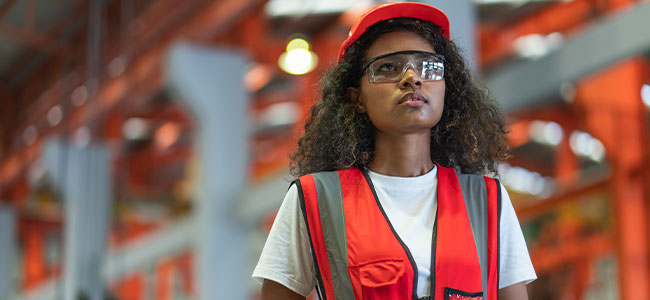
Choosing the Right Eye Protection for the Job
There are many product features built into today’s eye protection. What considerations should be made before choosing eye protection for the job?
OSHA requires employers to ensure the safety of all employees in the work environment. Eye and face protection must be provided whenever necessary to protect against chemical, environmental, radiological or mechanical irritants and hazards.
This may sound like a simple occupational mandate to comply with, however, not one single style of safety glass or goggle fits the needs of workers performing tasks in different industries. This alone begs the question, what are some key considerations that should be taken to ensure a worker is equipped with eye protection that protect them while providing optimal vision and all-day comfort?
Advanced Lens Technologies
To narrow down the best eye protection solution, employers should first consider the environment of the workspace. There are many advanced lens technologies used in modern-day safety lens manufacturing that are designed to provide workers with comfortable vision throughout the workday. These technologies will often boost the productivity and comfort levels of wearers:
• Anti-Reflective (AR) lens coatings will improve visual acuity in any application by reducing reflections and improving visible light transmission.
• I/O blue lenses combine a blue and slight yellow tint with a mirror coating to help prevent digital eye strain.
• Polarized lenses reduce glare in bright outdoor environments involving water, sand, rocks and concrete.
• Gradient tint lenses have a slight mirror coating on the top portion of the clear lens. This tint reduces glare from high-powered overhead fluorescent and mercury lighting helping to minimize squinting and eye strain.
• Mirror coated lenses will protect against bright sunlight and provide clearer vision through the lens when compared to a standard shaded lens.
Lens Colors
Even the lens color of a safety glass or goggle can serve a specific purpose, depending on the task, the lighting conditions, and the work environment. It’s important to consider what lens color works best for the environment and job at hand:
• Clear lenses are the most popular option for general use. Most polycarbonate safety glasses with clear lenses absorb 99.9 percent of UV rays.
• Amber lenses enhance visual acuity and are ideal for professional drivers or machine operators in all environments but notably foggy, rainy, or snowy conditions.
• Light blue colored lenses relieve eye strain from bright, overhead fluorescent lighting.
• Gray colored or shaded lenses provide a darkening effect with little color distortion, best used outdoors in bright or sunny environments.
• Green IR filter-rated lenses are designed to protect from welding arc and IR light. They should not be used for primary welding applications or while operating vehicles.
Advanced Lens Coatings
Most eye injuries occur when eye protection is not properly worn. If a worker takes their safety glasses or goggles off for even just a moment to wipe liquid or fog off of the lenses, this can heighten the chances for an eye injury on the job. Most manufacturers start with an anti-scratch and anti-fog coating to avoid obscured vision. Look for special treatments to extend the life of eyewear while enhancing vision by filtering out light and reducing glare. These coatings can help boost wearer acceptability in certain environments:
• Anti-Scratch (AS) is a treatment that toughens the lens surface for a longer product life with fewer scratches.
• Anti-Fog (AF) is a surface coating that reduces fogging to maintain clear vision. This coating is becoming very popular and is ideal for high-humidity environments.
• Indoor/Outdoor is a light mirror coating designed to provide enough light transmission to work indoors while reducing pupil adjustment time.
• Mirror coating reflects light attraction from the lens surface, great for bright environments in snow, sand, dirt and water.
Fit
Much like ear canals, people have different head/facial shapes and structures. There are thousands of styles and shapes of safety eyewear on the market today- some even with adjustable temples. It is recommended to have a few different styles of eyewear on site that best fit workers with rounder or narrower head and facial features. Shifting of eye protection can alter the coverage of safety glasses or goggles and result in eye injuries- making a secure fit crucial for workers performing dynamic movements.
Frame Linings
Many workers in different industries need eye protection from scratches and impacts along with protection from liquid splashes or airborne particles. Specific to goggles, it is important to understand the difference between direct and indirect ventilation as it relates to liquid protection. Direct-vented goggles help minimize fogging and should be used when there is no liquid splash risk. Direct-vented goggles have straight-line perforations that allow direct airflow from the work environment. Indirect-vented goggles help minimize fogging and should be used when there is liquid splash risk. Indirect vented goggles have hooded vents to allow indirect airflow from the work environment.
For exposure to airborne dust and dirt, foam lined eyewear can be a godsend to prevent these particles from obscuring workers’ vision. Employers may want to ensure that these types of glasses have anti-fog lenses, as glasses with foam padding can reduce airflow behind the lenses and cause lens fogging.
Simply put, it is a difficult, yet important task for employers to find a style of safety glass or goggle that closes the gap between protection, performance and comfort for all workers.
This article originally appeared in the April/May 2024 issue of Occupational Health & Safety.